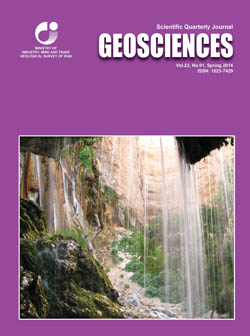Document Type : Original Research Paper
Authors
1 Associate Professor, Department of Geology, Faculty of Sciences, Urmia University, Urmia, Iran.
2 M. Sc., Department of Geology, Faculty of Sciences, Urmia University, Urmia, Iran.
Abstract
The Heydar-Abad laterite horizon is located at 65 km south of Urmia, West Azarbaidjan province. This horizon was developed as stratiform bed within the carbonate rocks of the late Permian Ruteh Formation. Based on the petrographical and mineralographical studies,the ores of this horizon contain micro-granular, fluidal-collomorphic, panidiomorphic-granular, spastoidic, pelitomorphic, nodular, and ooidic textures and have an authigenic origin. According to the mineralogical investigations, the ores of this horizon include minerals such as diaspore, corundum, hematite, magnetite, goethite, rutile, paragonite, margarite, amesite, berthierine, montmorillonite, chlorite, chloritoid, muscovite-illite, quartz, pyrite, anhydrite, calcite, and dolomite. The presence of high quantities of silicate minerals indicates immaturity and poor draining system during the development of this residual horizon. The results of chemical analyses show that Eu and Ce anomalies in the ores are within the ranges of 0.67 to 2.74 and 0.86 to 2.16, respectively. The calculations of values of enrichment factor of elements in two selected profiles reveal that two processes of leaching and fixation are major regulators of concentrations of REEs in ores of this horizon. The results obtained from the mineralogical and geochemical studies show that changes of pH of weathering solution, fluctuations of level of ground-waters, alteration intensity, and function of carbonate bedrocks as a geochemical barrier, adsorption, and scavenging have played an important role in distribution of the rare earth elements (REEs) in this deposit. The correlation coefficients show that the secondary phosphates, rutile and muscovite-illite are potential hosts for REEs in the ore.
Keywords

